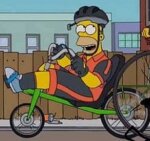Article: How Far is Too Far to Bike to Work
Our Community › Forums › Events › Article: How Far is Too Far to Bike to Work
- This topic has 80 replies, 32 voices, and was last updated 8 years, 4 months ago by
dasgeh.
-
CreatorTopic
-
February 27, 2017 at 6:36 pm #919142
Tim Kelley
Participant -
CreatorTopic
-
AuthorReplies
-
February 27, 2017 at 6:43 pm #1066983
 cvcalhounParticipant
cvcalhounParticipantI’m in the 11-15 range one-way. (I’m not sure how that fits into the chart, because it doesn’t specify one-way or round-trip.) I can do it, because I’ve been gradually increasing my distance for years. Before I started commuting, I was biking about that distance once a week–although as they say, it was still initially tough to do it five days in a row.
But I think the limiting factor for me is time, not distance. My current commute takes me only a little longer than car or public transit in the mornings, but quite a bit longer in the evenings. (It’s all uphill back to Bethesda.) If it were much longer, I just wouldn’t have time to do it on top of the long hours I work.
February 27, 2017 at 6:58 pm #1066984 lordofthemarkParticipant
lordofthemarkParticipantAs someone who had not been biking seriously before I began commuting, it took me quite some time to work up to doing my 10 mile commute comfortably, several times a week. If my commute had been much longer than that, I don’t know that I would have persisted to this point.
February 27, 2017 at 7:00 pm #1066985DrP
ParticipantThe general listing provided in the article is good. Many years ago I was 2 miles from work, and that was easy – even with the up-hill both ways (there was a ridge between me and my office). Now I am a bit under 9. It is do-able, but the time (I am not super fast), including the changing clothing time, adds up. If I need to be at the office early, then I am frequently not riding because I would have to leave so early and thus get no sleep the night before. I would be much happier with something more like 5-6 miles – enough to get some exercise, but not so much time. I would still do 40-80 miles on my Sunday rides.
February 27, 2017 at 7:36 pm #1066988Emm
ParticipantI agree with the article overall. I’m at the 14 mile mark right now, and we bought our house in this distance range because I refused to look at a bike commute further out than 15 miles because that’s the limit of what I felt I could handle as a daily commute. It’s definitely hard, but do-able if you’re dedicated.
I agree with Cvcalhoun’s point too. Once you get past a certain mileage other forms of transportation end up looking better due to time constraints. When I lived 4 miles out, biking was faster than driving or metro. When I lived 8 miles out, biking was about equal. At 14 miles out, driving is by far the fastest way to work (by about 20-30 min or so if you leave early enough in the AM). I think right now, from waking up to getting to my desk, biking takes me roughly an hour longer than when I drive. I expect it to drop to 30-40 min in the warmer months since I wont have to spend as much time in the AM layering up and de-layering at work for cold weather and fidgeting with lights, but we’ll see.
I also found gear/bike needs changed when I moved further out. I went from a flat-bar bike that I loved for the 4-8 mile range, to really relying more on my road bike for commutes. For the hour long commute, the drop bars are way more comfortable. The flat bar bike is now just my poor-weather bike. I also had to invest in more bike shorts and shirts, since the longer commute meant more sweat, and there’s only so many days in a row I can handle the same shorts/shirts without grossing out everyone around me.
February 27, 2017 at 7:51 pm #1066989bobco85
ParticipantI think the article is a good start at attempting to answer the question, but it by no means comes close to the answer. There are 2 major factors that popped into my head as I read it that were never addressed: topography (hills!) & infrastructure.
The topography around one’s home and work plays a key role in determining distance ability. Throw a few hills (especially steep ones) into the mix, and even short commutes become much harder.
Infrastructure also factors heavily into the ability for one to easily and quickly get to work (convenience). Biking on a road with 50 mph traffic gets more bearable when one has (preferably) separated infrastructure to use, and trails (especially those passing through parks/forests/nature/etc.) and calm streets can make travel much more accessible by being less stressful.
I didn’t think of this when I read the article, but another factor is family. Kids have appointments/games/trips to the hospital/etc., and one needs to have more flexibility to adjust to unexpected (remember when I said kids?) occurrences. Also, one wants to be able to have time to spend with family after a regular work day, so long distances can take up a lot of time.
Again, it’s a good start, but there’s a whole lot more that factors into deciding what distance is too far for bike commuting.
February 27, 2017 at 7:53 pm #1066990Crickey7
ParticipantMy own sense is that 12 miles is the point at which the alternatives become attractive again. 10 miles is the sweet spot in my book, as it’s also the distance at which you’re roughly as fast as a car in rush hour.
February 27, 2017 at 7:57 pm #1066991Crickey7
ParticipantWait, was he serious about wax in his hair? Is that some British term for hair gel or mousse or something?
February 27, 2017 at 8:04 pm #1066992 bentbike33Participant
bentbike33Participant@Crickey7 155953 wrote:
Wait, was he serious about wax in his hair? Is that some British term for hair gel or mousse or something?
Either that, or a throwback to the early 1960’s…
[ATTACH=CONFIG]14026[/ATTACH]
February 27, 2017 at 8:30 pm #1066993Phatboing
ParticipantI’m in the 11-15 (with the occasional 10.5), and it can get get hard in ways that are different from the 600-800 feets of climbing each way:
- It takes an hour-ish each way, which is quite a bite out of the day in the peak of winter.
- Even if there’s just light rain, it’s definitely enough distance to breach at least one piece of gear (I know, I know, better gear, but still)
- If I go to bed late, I pay a high price – I’m sluggish getting to work, and generally slow the rest of the day. And those hills don’t go away…
- I could start in dry weather, and realize as I cross Lake Washington that my workplace is having a rainy day instead.
- If I’m tired, it’s still the same distance. My commute from Falls Church to Tysons could be cut down to 5-ish miles if I wasn’t feeling up to it (or needed to be somewhere)
But I get to see mountains on the clear days, and breaks even with transit, so there’s that.
February 27, 2017 at 8:54 pm #1066996 cvcalhounParticipant
cvcalhounParticipant@bobco85 155951 wrote:
I didn’t think of this when I read the article, but another factor is family. Kids have appointments/games/trips to the hospital/etc., and one needs to have more flexibility to adjust to unexpected (remember when I said kids?) occurrences. Also, one wants to be able to have time to spend with family after a regular work day, so long distances can take up a lot of time.
In DC, less than 26% of cyclists are female. And this is a big reason why. The expectation that women will be responsible for hauling kids places, and the difficulty of doing so on a bicycle, means that women just don’t cycle to the extent men do. And this is exacerbated by the fact that hauling the kids sometimes occurs unexpectedly, in the middle of a work day (when a kid gets sick or has an accident). So if the woman is the one responsible for dealing with those occurrences, she may be reluctant to cycle to work in the first place for fear she won’t be able to get back as quickly when necessary.
Of course, I’d really like to see a less sexist division of labor, which would have a bonus of allowing women to bicycle more often. But as things stand, it is definitely an issue.
@Crickey7 155952 wrote:
My own sense is that 12 miles is the point at which the alternatives become attractive again. 10 miles is the sweet spot in my book, as it’s also the distance at which you’re roughly as fast as a car in rush hour.
I would agree with you. My commute is 12.5 miles each way. And driving, public transit, and cycling take approximately equal time to get to the office at this distance, but cycling definitely takes more time getting home. Much more, and cycling would become impractical for me.
February 27, 2017 at 8:55 pm #1066997 JuddParticipant
JuddParticipant@bentbike33 155954 wrote:
Either that, or a throwback to the early 1960’s…
[ATTACH=CONFIG]14026[/ATTACH]
Or to Steve O in the early 2017’s.
February 27, 2017 at 8:56 pm #1066998 JuddParticipant
JuddParticipant@Tim Kelley 155942 wrote:
https://mobilitylab.org/2017/02/27/how-far-bike-work/
What’s the consensus?
As far as one needs to ride daily to look good whilst naked.
February 27, 2017 at 9:02 pm #1067000 cvcalhounParticipant
cvcalhounParticipant@Crickey7 155953 wrote:
Wait, was he serious about wax in his hair? Is that some British term for hair gel or mousse or something?
Apparently, it’s a real thing, which is not the same as gel or mousse.
@Judd 155960 wrote:As far as one needs to ride daily to look good whilst naked.
At my age, I’m not sure 500 miles a day would be enough!
February 27, 2017 at 9:02 pm #1067001Tim Kelley
Participant@cvcalhoun 155958 wrote:
In DC, less than 26% of cyclists are female. And this is a big reason why.
Not to disagree, but for further clarification:
According to the latest user survey, more than 40 percent of Capital Bikeshare members are estimated to be women.
Also, several studies have examined the disparity between male and female ridership and one theory to explain this that has been suggested is that women are more risk-adverse and prefer not to ride in places that do not have separate or protected facilities.
February 27, 2017 at 9:12 pm #1067002 cvcalhounParticipant
cvcalhounParticipant@Tim Kelley 155963 wrote:
Not to disagree, but for further clarification:
According to the latest user survey, more than 40 percent of Capital Bikeshare members are estimated to be women.
Also, several studies have examined the disparity between male and female ridership and one theory to explain this that has been suggested is that women are less risk-adverse and prefer not to ride in places that do not have separate or protected facilities.
I suspect Capital Bikeshare riders have a higher percentage of females, in part because a) they are often used by tourists, who are less likely to get called home suddenly, and b) they are often used just to get to and from Metro, rather than for long rides when you have to pick stuff–or children–up. The “under 26%” figure comes from WABA.
I don’t know that women are more risk-averse. (I assume you mean more, not less.) But I suspect that biking is more risky for them. Women are more vulnerable to assault (both sexual assault, and assault just because they are on average smaller and weaker) than men are. And I long believed that drivers in general tended to honk and curse at cyclists, and often drive way too close to cyclists, who do perfectly legal things like taking the lane. But comparing notes with male cyclists suggest that they do it many times more often with women than with men. Having this happen many times on each ride can easily leave one feeling too intimidated to keep going.
-
AuthorReplies
- You must be logged in to reply to this topic.